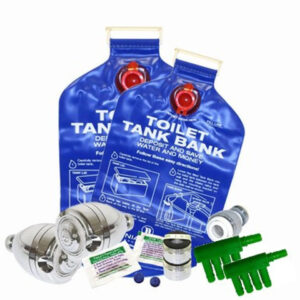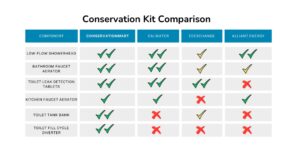 Water and energy conservation is more important than ever, and there’s a wide range of products that can help save energy and water around the house. Some homeowners take proactive steps to install water and energy-saving devices. But conservation kits can take the guesswork out of the process by providing a variety of conservation tools and devices in a single convenient package.
Water and energy conservation is more important than ever, and there’s a wide range of products that can help save energy and water around the house. Some homeowners take proactive steps to install water and energy-saving devices. But conservation kits can take the guesswork out of the process by providing a variety of conservation tools and devices in a single convenient package.
Increasingly, utility companies and local water districts have begun to offer conservation kits to their users. It’s an effective way to encourage customers to conserve resources, which helps relieve strain on overtaxed energy grids and water systems. Nonprofits focused on environmental sustainability also offer conservation kits as a way to help families reduce their energy consumption. In both contexts, kits also serve as an effective education tool to help the public learn about conservation.
Not all conservation kits are created equal, however, and finding the best conservation kits on the market can be a daunting task.
In this article, we’ll compare and contrast three different water conservation kits that are particularly popular online: one from California utility company CalWater, one from Alliant Energy, an Environmental Education Exchange kit (EEExchange) distributed by Tuscon Water, and our own kit, from ConservationMart.com
We should begin by saying that any of these four kits would make a great addition to your home. They all contain useful conservation tools that can help you save resources.
With that said — you may not be shocked to hear that we believe that Conservationmart kits are the best conservation kits around. We’ve worked hard to ensure that the components in our kits are useful, simple to install, and can make a real difference in household resource use.
The chart below shows what each kit contains, and what each one leaves out. We’ll discuss the importance of each component below and then compare the kits you see here.

Key Components of the Best Conservation Kits
There are some components we believe should be included in all good conservation kits, and a conservation kit that lacked the items listed below isn’t one we would recommend. We’ll talk below about these “essential ingredients” and the purpose they serve.
Low-Flow Showerhead
A low-flow showerhead is a fixture designed to reduce water consumption while maintaining strong water pressure. They commonly reduce flow to 1.5 gallons per minute (GPM), using significantly less water than standard showerheads, which may use 2.5 GPM or more.
Using a low-flow showerhead not only conserves water, but also reduces energy use by minimizing the amount of hot water required for daily use, lowering utility bills. Because showers are a significant source of water consumption, we think every conservation kit should include a low-flow showerhead.
Bathroom Faucet Aerator
Faucet aerators attach to the end of a faucet, mixing air with water to reduce flow while maintaining water pressure. These aerators are a critical tool for limiting unnecessary water waste. This is another must-have for any conservation kit.
Kitchen Faucet Aerator
A kitchen faucet aerator works just like a bathroom faucet aerator, but generally allows for a slightly higher flow rate, which is needed for kitchen tasks. Many kitchen faucet aerators (including the ones in Conservationmart conservation kits) feature a swivel function that makes it easier to rinse dishes and clean sinks with less water. No conservation kit is complete without one.
Toilet Leak Detection Tablets
Toilet leak detection tablets help identify silent toilet leaks, which can waste thousands of gallons of water per year. Users drop a tablet into the toilet tank, and if the water in the bowl changes color without flushing, it indicates a leak. Detecting and repairing leaks early prevents unnecessary water waste and lowers water bills, making toilet leak detection tablets a simple yet effective conservation tool that should be in any complete kit.
Toilet Tank Bank
This device is a water displacement bag that sits in the toilet tank, reducing the amount of water used per flush without affecting the toilet’s performance. Unlike bricks or other DIY methods, a quality toilet tank bank is designed to prevent tank damage while saving up to 0.8 gallons per flush. It’s a low-cost, easy-to-install solution for reducing household water usage.
Toilet Fill Cycle Diverter
This small device optimizes the toilet’s fill cycle by diverting excess water from the bowl to the tank, ensuring both fill at the same rate. By preventing unnecessary bowl overfilling, it can save up to half a gallon of water per flush. Since toilets are among the largest indoor water consumers, a toilet fill cycle diverter helps reduce overall water usage and utility costs efficiently. This is another must-have in any good conservation kit.
The Best Conservation Kits
We already let you know that — no surprise — we humbly suggest that our conservation kit is the best conservation kit available online. We’ll explain more about our choice below.
1. Conservationmart Conservation Kit
When all is said and done, Conservationmart offers the best conservation kits among the groups we analyzed. For example, our kit includes two faucet aerators while Alliant Energy and EEExchange offer only one. The CalWater and Alliant kits don’t include toilet tank banks at all, and EEExchange offers only one. Worse, none of the three kits include fill cycle diverters. These are items that we think are critical for a complete conservation kit. Toilets account for about 30 percent of household water use, so they offer a major opportunity for water savings that shouldn’t be overlooked.
2. CalWater Conservation Kit
The CalWater kit includes a lot of the components usually contained in the top conservation kits. It features two low-flow shower heads, both bathroom and kitchen sink aerators, and toilet leak-detection tablets. These are all great additions to the kit.
The lack of toilet tank banks and fill cycle divertors in this kit, however, are an oversight from our perspective. Given how much toilets account for household water use, these are important tools for users looking to make a dent in their water consumption.
3. Alliant Energy Conservation Kit
The Alliant energy conservation kit contains many of the components we think are important for the best conservation kits. It only offers one bathroom faucet aerator, however, and includes neither a kitchen faucet aerator or a toilet fill cycle diverter. Without those items, we can’t rank it among the best conservation kits out there.
4. EEExchange Conservation Kit
The EEExchange conservation kit is unusual in that it’s technically not a kit; the components offered have to be ordered individually. That in itself is a drawback as far as we’re concerned, because one of the main benefits of conservation kits should be taking the guesswork out of conservation.
With that said, it’s possible to assemble a decent kit from the components offered. There are some key components missing, however, like a kitchen faucet aerator and a toilet fill cycle diverter. We’d rank this kit higher if it offered these important additions.
Conclusion
And there you have it — our view of the best conservation kits around today. While any of these kits will be a beneficial addition to your home, we’ve worked hard to create what we think is the best conservation kit around. We’ve also helped dozens of clients assemble the kit that will work best for their needs. To speak to one of our representatives about assembling that perfect kit, give us a call today: 1-800-789-8598
